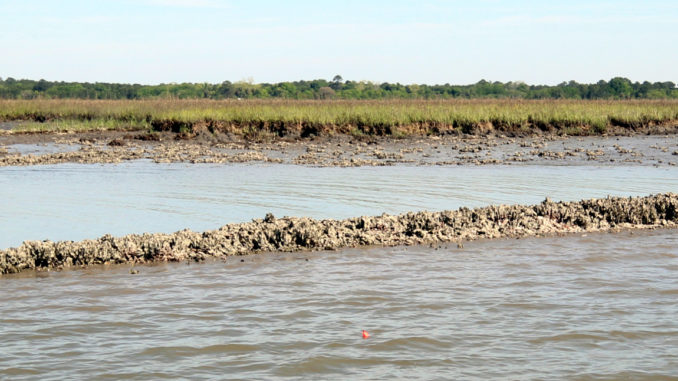
The Coosaw River does not contain any “honey holes” where the fishing is better than anywhere else. This is one of the reasons crowds are rarely an issue; if a boat is on one spot, there are literally several dozens of others to chose from where the fishing is just as good.
On the low tide, many flats that are good choices are within sight of the mouth of Lucy Creek and Sams Point Landing. Directly across from Lucy Creek on the north bank of the river are several good flats.
Things to look for are shallow flats that are wide and have small creeks or ditches bisecting them. These are favorite areas for redfish because they can easily ambush prey that washes out from the draining marsh. Also, small creeks act as highways reds can easily use to get on and off of flats. The bottom of these drainages are great places to locate flounder as well.
On slightly higher water, any oyster bed out from the grass line is usually a good choice; literally hundreds are available to choose from. Also, target oyster beds with nearby ditches and small creeks draining the marsh and a slower current. An oyster bed that away from the bank but still not in the hard current with good drainage nearby is a very likely spot for redfish to gather. Many beds such as this are found very near Sams Point landing in Lucy Creek.
Any creek on the Coosaw may have trout hanging around. They tend to move around, and it is not unusual for them to leave one creek and move to another from season to season. Smaller creeks 10 to 20 feet wide are the best bets. Look for eddies and current breaks near a high bank at the mouth of the creek and work the edge of the currents. If nothing happens in a few minutes, look for another spot until you find trout.
Targeting redfish working the grass line can seem like searching for a needle in a haystack, but by narrowing it down, it can be quite simple. Redfish like to root around in the grass as soon as it’s flooded, so search out the grass that is in the water first. A good indicator is secondary grasslines where clumps of grass are located away from the thicker and higher marsh. Reds will stage in these areas and work the smaller clumps of grass until there is enough water for them to get into the higher grass. Also, on the outgoing tide, reds will stay in these same grassy areas as long as there is enough water for them. As with other areas, the close proximity to small creeks and ditches is an indicator of better fishing potential. Good places to search for these secondary grass lines are on the far end of Coosaw Island and where the Combahee River and Coosaw meet up to form the St. Helena Sound.




Be the first to comment